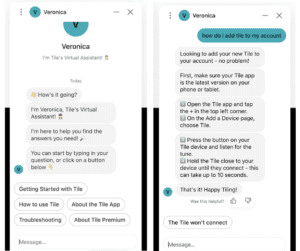A year after deploying a new chatbot tool, Tile Inc., a manufacturer of Bluetooth tracking devices, now boasts a 52% containment rate of nearly 50,000 customer inquiries, meaning roughly half of shoppers who interact with Tile’s new chatbot don’t have to speak with a live human agent.
Tile has used Zendesk’s customer service software platform since 2013. Previously, Tile outsourced escalated customer service inquiries that could not be resolved by answers provided on the website to a manual ticket and agent system. That system cost Tile time and negatively impacted containment rates—particularly during the holiday season.
In September 2020, Tile revamped its approach to resolving customer questions by adding Ada’s chatbot into Zendesk’s system. Zendesk began working with Ada in 2018, using Ada’s artificial intelligence technology to train chatbots to complete simple tasks while also identifying when a shopper needs to be transferred to a live agent. Ada’s agent chatbot was up and running within 29 days. Ada uses a natural language processing-powered chatbot as the shopper’s first line of assistance and can answer the majority of questions, according to Zendesk/Ada. Inquiries not resolved by Ada are then moved to Tile’s Zendesk agents.
“The automated chat experience feels conversational and genuinely feels like a seamless part of our customer experience,” says Justin Michaud, senior manager of customer support at Tile, No. 786 in the Digital Commerce 360 Top 1000.
Before implementing the chatbot, Michaud says the retailer’s forecasting models predicted a 25-30% containment rate. “It was a happy surprise for us from a containment perspective—right out the gate,” Michaud says. “Before using Ada, there was no metric for containment because we didn’t have a live agent bot. It’s a new metric for us.”
When a shopper has a question, they can click on the help header at the top of the web page. This leads to a landing page with a search bar to type in a question. Categories are listed beneath the search bar, which include video tutorials, technical support, order inquiries, account and setup, and contact customer care, which list frequently asked questions with answers. Anchored at the bottom right of the webpage is a chat bubble that will allow shoppers to bypass the above and begin chatting with a bot directly.

When a customer wants live support, they are connected via chat. When agents aren’t online, the customer receives a personalized message, or if agents are at capacity, the customer is placed in queue.
The bot can answer questions related to troubleshooting, such as connecting a Tile device with the app. It will suggest steps a customer can take to fix the issue. If the problem persists, the chatbot then asks the customer to provide the email address associated with the order and connects the customer with a service agent who answers questions directly.
“We wanted a chatbot system that would actually understand what the customers were asking and be able to present a valid answer quickly,” Michaud says. “We can answer a lot more questions a lot faster than we could before.”
With the new system, Tile reduced its outsourced customer service staff, which significantly cut back its overhead costs. Tile declined to reveal the cost of using Ada and how much it reduced its staff. But, in May 2021, after six months using the chatbot tool, Tile says its return on investment was a 291% reduction of costs. Since then, savings have plateaued.
The chatbot system transfers escalated questions ,“that required a more human touch to the right agents at the right time,” Michaud says.
In Digital Commerce 360’s Pre-Holiday Retailer Survey conducted from July-September 2021, retailers were asked to define in which areas they made investments to boost holiday business. 44% of retailers reported investing in customer experience, while 39% reported investing in customer service. Also, 32% said investing in live chat was very important.
The holiday rush for Tile’s customer service team
This year, Tile anticipates an increase in holiday-related inquiries beginning at the end of November, from Black Friday through Christmas.
In the future, Tile plans to use the bot with its back-end systems to help with more complex customer questions—such as “Where is my order?” Currently, customers are redirected to a landing page where they can manually input their email and order number.
While Ada’s bots are not set up to automatically answer order-specific tracking questions for 2021’s holiday season without redirecting customers, “the bot can still answer a lot of the other volume we get during the holidays,” Michaud says.
The bot brings in live agents for escalated questions, “so we still see that part of the win,” he says. “And that’s what we’re planning for right now—staffing up and having the team ready for a lot of order-related questions since we know the bot can handle most of the other questions.”
Shoppers can access the chatbot while shopping using a web browser or within Tile’s phone app. Tile wants to better integrate the chatbot into its app. Currently, when shoppers click on customer care within Tile’s phone app, it brings up a web view version of the chatbot.
“I would prefer to get customer care integrated into our app,” Michaud says. “That way we know more information about the customer chatting with us [from the beginning of the interaction], and we can speed up and personalize the experience.”
Tile plans to identify additional ways to further its automation strategy in its customer experience. The retailer also plans to deploy the bot on its sales pages to help drive more conversions as well as upsell and cross-sell efficiently.
Favorite